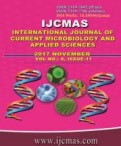


 National Academy of Agricultural Sciences (NAAS)
National Academy of Agricultural Sciences (NAAS)

|
PRINT ISSN : 2319-7692
Online ISSN : 2319-7706 Issues : 12 per year Publisher : Excellent Publishers Email : editorijcmas@gmail.com / submit@ijcmas.com Editor-in-chief: Dr.M.Prakash Index Copernicus ICV 2018: 95.39 NAAS RATING 2020: 5.38 |
A field experiment was conducted during pre-kharif season of 2010 and 2011 at the C-Block Farm of Bidhan Chandra Krishi Viswavidyalaya, Kalyani to find out the effect of different weed management practices on growth and yield of jute (cv. JRO-524). The experiment was designed with eight treatments (weed management practices) and tested under Randomized Block Design with three replications. The weed management practices comprised of different doses of chemical herbicides like Fenoxaprop-P-Ethyl and Quizalofop-Ethyl as post emergence spray at 30 DAS; botanical herbicides like Calotropis and Parthenium (5% raw extract) as pre emergence spray at 1 DAS in combination with hand weeding. The highest jute fibre yield was recorded in hand weeding twice at 15 and 30 DAS (3.91 t ha-1 in 2010 and 3.98 t ha-1 in 2011) which was closely followed by Quizalofop-Ethyl @ 100 g ha-1at 30 DAS + Hand weeding at15 DAS (3.89 t ha-1 in 2010 and 3.95 t ha-1 in 2011 respectively). The benefit cost ratio was highest in Quizalofop-Ethyl @ 100 g ha-1 at 30 DAS + Hand weeding at15 DAS (1.96 in 2010 and 1.39 in 2011 respectively). From the present experiment, it can be concluded that the spraying of Quizalofop-Ethyl @ 100 g ha-1 at 30 DAS + Hand weeding at 15 DAS would be beneficial practice to the jute farmer of West Bengal.
 |
 |
 |
 |
 |